Mary Blathwayt
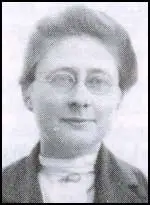
Mary Blathwayt, the daughter of Colonel Linley Blathwayt, a retired army officer, and Emily Blathwayt, was born in 1879. Her father was an officer in the British Indian Army and served in India for many years. Blathwayt retired from the army and in 1882 he purchased Eagle House near Batheaston, a large house set in four acres of land.
Linley Blathwayt was a supporter of the Liberal Party. Mary and her mother also held progressive political views and were both advocates of women's suffrage. Mary and her mother devoted much of their time to teaching music to village children.
According to B. M. Willmott Dobbie, the author of A Nest of Suffragettes in Somerset (1979): "Mary led the sheltered life of an upper middle-class daughter at home, paying and receiving calls, helping with charitable events in the village, working in the garden and tending her hens, for whom she had an especial fondness, taking an active part in the Avon Vale Musical Society, giving violin lessons to village boys, who invariably disappointed her.... There were cycle rides with girl friends, and tours with her brother William, whom they always stayed in Temperance Hotels."
In July 1906 she sent a donation of 3 shillings to Women's Social and Political Union (WSPU). Her mother and father also supported the Women's Suffrage bill being discussed in the House of Commons. In March 1907 Emily Blathwayt wrote: "Women's Suffrage bill brought in by private member and government allowed it to be talked out. The Liberals do not keep their pledges. The Women's Union beg all to turn against Liberals and think only of the one Cause. Linley is much in favour of women having the vote, he thinks they would do much more good than harm."
Mary became friends with Lilias Ashworth Hallett, who was a member of the NUWSS and the WSPU. In March 1908 she was introduced to Millicent Fawcett. In her diary she wrote: "This afternoon I went into Bath by tram and then walked to Claverton Lodge... Mrs. Ashworth Hallett introduced me first to Miss Clark, and then to Mrs. Fawcett. Then others came in: Dr. Mary Morris... We all had tea there and stayed talking till 6.30. I have never been to the house before; it is a beautiful place. Mrs. Hallett is most kind. I could not believe I was looking at Mrs. Fawcett, she looks so young. I believe she has been working for Votes for Women for 40 years."
Mary Blathwayt first met Annie Kenney at a WSPU meeting in Bath. According to Elizabeth Crawford, the author of The Suffragette Movement (1999), claims that Blathwayt had fallen "under her spell and gave her a rose". Soon afterwards Kenney introduced her to Emmeline Pethick-Lawrence and Christabel Pankhurst. She now became an active member and over the next few weeks she began distributing WSPU leaflets in the area.
In May 1908 Mary agreed to help Annie Kenney, Elsie Howey, Clara Codd and Mary Phillips to organise the women's suffrage campaign in her area. She wrote in her diary: "This afternoon I helped Annie Kenney make her plans for a West of England campaign, I wrote out lists of towns and dates which are to be sent to Mrs. Pankhurst and Mrs. Pethick Lawrence. This evening Miss Howey went round the town with some steps, and I went with her. And when we came to a crowd she got onto the steps and shouted Keep the Liberal out. Votes for Women". Mary also a public meeting that was addressed by Gladice Keevil. She recorded in her diary: "She and I held an open air meeting at the Wharf. I took the chair, the first time I have ever done such a thing. I read out a few words of introduction, announced a meeting for tomorrow and called upon Miss Keevil to speak."
By December of that year Mary Blathwayt was elected to the executive committee of the local branch of the WSPU. Blathwayt became very friendly with Annie Kenney. The two women spent much of 1908 and 1909 speaking "from dogcarts at open-air meetings, chalked pavements and sold pamphlets." However, she refused to become involved in any activity that might risk her being arrested. In July 1909 she refused a written request from Emmeline Pankhurst to join a deputation "which carried with it the virtual certainty of a prison sentence." The reason that she gave was that "father would not like it". She also noted in her diary that "Annie Kenney does not wish me to go."
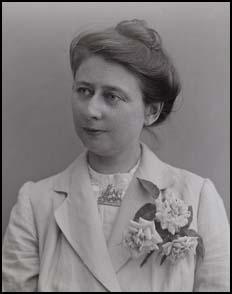
Emmeline Pethick-Lawrence wrote an article in Votes for Women in February 1909, they acknowledged the help given by the Blathwayt family to the cause of women's suffrage: "I say to you young women who have private means or whose parents are able and willing to support you while they give you freedom to choose your vocation. Come and give one year of your life to bringing the message of deliverance to thousands of your sisters... Put yourself through a short course of training under one of our chief officers or at headquarters in London, and then become one of our honorary staff organisers. Miss Annie Kenney, in the West of England, has two such honorary organisers. Miss Blathwayt is the only daughter of Colonel Lindley Blathwayt, of Bath. Yet her parents have set her free with their fullest approbation and sympathy, and with a generous allowance, to devote her whole time to the work."
On 8th June, 1909, Mary recorded in her diary how she and Elsie Howey were attacked during one public meeting in Bristol. "We were on a lorry and a large crowd of children were waiting for us when we arrived. Things were thrown at us all the time; but when we drove away at the end we were hit a great many times. Elsie Howey had her lip hit and it bled. I was hit by potatoes, stones, turf and dust. Something hit me very hard on my right ear as I was getting into our tram. Someone threw a big stone as big as a baby's head; it fell onto the lorry."
Elizabeth Crawford claims Annie Kenney spent a lot of time at Mary Blathwayt's home, Eagle House near Batheaston "where, for the first time, she began to learn French, to play tennis, to swim, to ride and to drive." A fellow member of the WSPU, Teresa Billington-Greig claimed that Kenney was "emotionally possessed" by Christabel Pankhurst during this period. However, Mary argued that it was Kenney who was the dominating personality as she had a "wonderful influence over people".
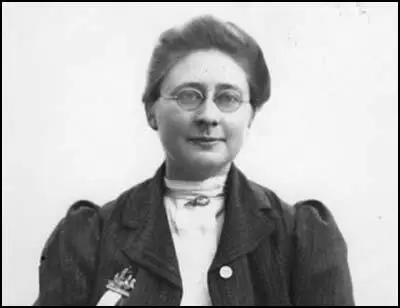
Fran Abrams the author of Freedom's Cause: Lives of the Suffragettes (2003), has argued that Annie Kenney had a series of romantic attachments with other suffragettes: "The relationship (with Christabel Pankhurst) would be mirrored, though never matched in its intensity, by a number of later relationships between Annie and other suffragettes. The extent of their physical nature has never been revealed, but it is certain that in some sense these were romantic attachments. One historian who argues that Annie must have had sexual feelings for other women adds that lesbianism was barely recognised at the time. Such relationships, even when they involved sharing beds, excited little comment. Already, Christabel had formed a close friendship with Esther Roper and Eva Gore-Booth, suffrage campaigners who lived together in Manchester. Her relationship with Eva, in particular, had become intense enough to excite a great deal of comment from her family - according to Sylvia."
Colonel Linley Blathwayt was sympathetic to the WSPU cause and he built a summer-house in the grounds of the estate that was called the "Suffragette Rest". Members of the WSPU who endured hunger strikes went to stay at Eagle House and the summer-house. Mary Blathwayt recorded in her diary that Annie Kenney had intimate relationships with at least ten members of the WSPU at Batheaston. Blathwayt records in her diary that she slept with Annie in July 1908. Soon afterwards she illustrated jealousy with the comments that "Miss Browne is sleeping in Annie's room now." The diary suggests that Annie was sexually involved with both Christabel Pankhurst and Clara Codd. Blathwayt wrote on 7th September 1910 that "Miss Codd has come to stay, she is sleeping with Annie." Codd's autobiography, So Rich a Life (1951) confirms this account.
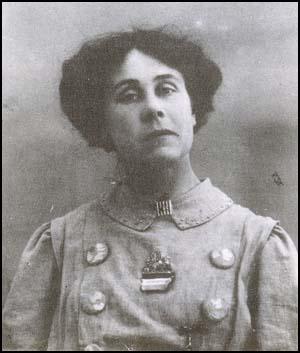
The historian, Martin Pugh, points out that "Mary writes matter-of-fact lines such as, Annie slept with someone else again last night, or There was someone else in Annie's bed this morning. But it is all done with no moral opprobrium for the act itself. In the diary Kenney appears frequently and with different women. Almost day by day Mary says she is sleeping with someone else."
Colonel Linley Blathwayt decided to create a suffragette arboretum in a field adjacent to the house. The idea was for women to be invited to plant a tree to commemorate their prison sentences and hunger strikes. On 23rd April 1909 Emily Blathwayt recorded in her diary that Annie Kenney, Emmeline Pethick-Lawrence, Constance Lytton and Clara Codd all planted trees. "Beautiful day for the tree planting and Linley photographed the three in a group at each tree. Annie put the West one, Mrs. P. Lawrence, South, and Lady Constance the East. Miss Codd came to the field."
Over the next few months Emmeline Pankhurst, Adela Pankhurst, Mary Phillips, Vera Holme, Jessie Kenney, Georgina Brackenbury, Marie Brackenbury, Aeta Lamb, Theresa Garnett, Lilian Dove-Wilcox, Adela Pankhurst, Marion Wallace-Dunlop, Vera Wentworth and Elsie Howey also took part in this ceremony. After the visit of Christabel Pankhurst Emily Blathwayt wrote in her diary: "Christabel has planted her cedar of Lebanon by the pond; it was raining all the time. There is a wonderful charm about Christabel; she looks sweet and not like her photo. She is quiet and retiring." Eventually, even women who had not been to prison, such as Millicent Fawcett and Lilias Ashworth Hallett planted trees.
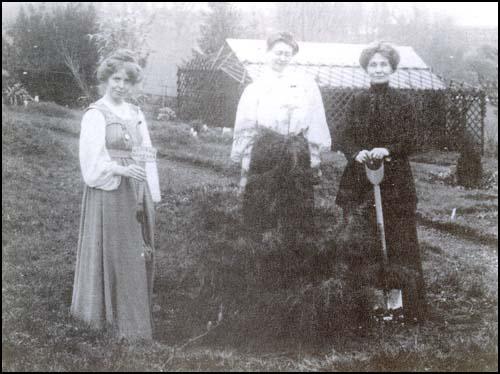
Jessie Kenney developed a "lung condition" also spent time recovering at Eagle House in 1910. Others who visited during this period included Constance Lytton, Elsie Howey, Mary Phillips, Charlotte Despard, Mary Allen, Charlotte Marsh, Lilias Ashworth Hallett, Aeta Lamb, Georgina Brackenbury, Marie Brackenbury, Marie Naylor, Laura Ainsworth, Margaret Haig Thomas, Lilian Dove-Wilcox, Theresa Garnett, Gladice Keevil, Maud Joachim, Vida Goldstein, Minnie Baldock, Vera Wentworth, Clare Mordan and Helen Watts. Colonel Blathwayt photographed the women. These were then signed and sold at WSPU bazaars.
In April 1911 Mary Blathwayt took part in the campaign to undermine the national census. She wrote in her diary: "I went into Bath last night by tram and walked to 12 Lansdown Crescent (an empty house rented for the purpose by Mrs. Mansel) to spend the night there and so evade the census, as a protest against the Government for not giving us Votes for Women. I got there before 10 o'clock. A little crowd of people were standing in the next doorway on the east side to watch us go in. I took a nightdress etc. with me and had a room to myself on the 1st floor and a bed. Everyone else slept on mattresses. We had a charming room to hold our meeting, beautifully decorated and very comfortable. There were 29 of us... We sat up until 2 a.m. this morning."
Annie Kenney wrote in her memoirs, Memories of a Militant (1924) about the help that the Blathwayt family gave her during the campaign: "It would be futile to mention other names, they were all wonderful to me. There is just one I should like to mention, that of the late Colonel Blathwayt. He and Mrs. Blathwayt, of Eagle House, Batheaston treated me as though I were one of their own family. All my week-ends I spent under their hospitable roof."
In November 1912 Emily Blathwayt recorded in her diary that she was unhappy about her daughter's participation in the WSPU. "Mary in Bath all day working for the Pankhurst cause - we wish she was not, but the young people all do this kind of thing now and I suppose it is evolution. The oldest supporters are fast leaving the WSPU, especially those old in years, but people like Miss Lamb do not at all like Mrs. Pankhurst's present policy."
The summer of 1913 saw a further escalation of WSPU violence when they began an arson campaign. In July attempts were made by suffragettes to burn down the houses of two members of the government who opposed women having the vote. These attempts failed but soon afterwards, a house being built for David Lloyd George, the Chancellor of the Exchequer, was badly damaged by suffragettes. This was followed by cricket pavilions, racecourse stands and golf clubhouses being set on fire. In June 1913 a house had been burned down close to Eagle House. Under pressure from her parents, Mary Blathwayt resigned from the WSPU.
In her diary she wrote: "I have written to Grace Tollemache (secretary for Bath) and to the secretary of the Women's Social and Political Union to say that I want to give up being a member of the W.S.P.U. and not giving any reason. Her mother, Emily Blathwayt, wrote in her diary: "I am glad to say Mary is writing to resign membership with the W.S.P.U. Now they have begun burning houses in the neighbourhood I feel more than ever ashamed to be connected with them."
Emily and Mary remained active member of the NUWSS. Emily wrote in her diary on 7th February, 1918: "The Reform Bill passed yesterday... Women cannot vote before the age of 30. Wives of men entitled to elect can vote as well as women in their own right and university women also have the franchise... Linley and I walked through the trees this afternoon and wondered how quietly this had come at last, but the war occupies all our thoughts."
Mary Blathwayt continued to live in Batheaston until her death in 1962. Eagle House was sold soon afterwards. B. M. Willmott Dobbie, the author of A Nest of Suffragettes in Somerset (1979), has pointed out: "The land was sold for building. Bulldozers tore down the suffragette trees, and blithely smashed many of the plaques. A number were rescued, however, and are in the museum of the Batheaston Society."
Primary Sources
(1) Mary Blathwayt, diary entry (13th February, 1908)
Mrs. Pankhurst was tremendously cheered when she first came in. She decided to carry a resolution to the House of Commons. She started in a pony carriage, but shortly after she got into Victoria Street, she was arrested, and others also. We all marched on to Westminster Abbey where we were stopped by the police. We went back to the Caxton Hall and there Mrs. Pethick Lawrence collected and received promises to the amount of £400.
(2) Emily Blathwayt, diary entry (14th February, 1908)
Mary came home after being all the morning in the Police Court with the friends of the prisoners. They all feel miserable about self-sacrificing Mrs. Pankhurst, who is condemned to six weeks confinement like a criminal. Mary asked the policeman whether, if she went out to buy some food, she could get in again, and he said he would see to it. So she bought a huge bag of buns, some fruit and chocolate and distributed them among the people. The policemen were all so good to the women and were wearing "Votes for Women" buttons under their cloaks and so were the reporters, and asking for some for their wives.
(3) Mary Blathwayt, diary entry (8th March, 1908)
This afternoon I went into Bath by tram and then walked to Claverton Lodge... Mrs. Ashworth Hallett introduced me first to Miss Clark, and then to Mrs. Fawcett. Then others came in: Dr. Mary Morris... We all had tea there and stayed talking till 6.30. I have never been to the house before; it is a beautiful place. Mrs. Hallett is most kind. I could not believe I was looking at Mrs. Fawcett, she looks so young. I believe she has been working for Votes for Women for 40 years.
(4) Mary Blathwayt, diary entry (11th May, 1908)
Miss Keevil came over from Market Drayton ... She and I held an open air meeting at the Wharf. I took the chair, the first time I have ever done such a thing. I read out a few words of introduction, announced a meeting for tomorrow and called upon Miss Keevil to speak.
(5) Mary Blathwayt, diary entry (13th May, 1908)
This afternoon I helped Annie Kenney make her plans for a West of England campaign, I wrote out lists of towns and dates which are to be sent to Mrs. Pankhurst and Mrs. Pethick Lawrence. This evening Miss Howey went round the town with some steps, and I went with her. And when we came to a crowd she got onto the steps and shouted "Keep the Liberal out. Votes for Women".
(6) Mary Blathwayt, diary entry (19th June, 1908)
This evening Annie Kenney told us some things about prison. The arrangements there are very bad indeed, all food has to be carried to the mouth in fingers, no spoon or fork is allowed. For breakfast they have dry bread and some very nasty tea. Dinner two potatoes and a piece of meat; which must be held in the fingers. The sanitary arrangements are very bad indeed. The treatment makes bad women worse, and many go mad.
(7) Emmeline Pethick-Lawrence, Votes for Women (11th February, 1909)
I say to you young women who have private means or whose parents are able and willing to support you while they give you freedom to choose your vocation. Come and give one year of your life to bringing the message of deliverance to thousands of your sisters... Put yourself through a short course of training under one of our chief officers or at headquarters in London, and then become one of our honorary staff organisers. Miss Annie Kenney, in the West of England, has two such honorary organisers. Miss Blathwayt is the only daughter of Colonel Linley Blathwayt, of Bath. Yet her parents have set her free with their fullest approbation and sympathy, and with a generous allowance, to devote her whole time to the work. She is Miss Kenney's right hand in Bristol. Miss Elsie Howey is honorary organiser in Plymouth. She is the daughter of Mrs. Howey, of Malvern. Mrs. Howey and her two daughters have given generously of all that they have, but the best prized gift is the life-work of this noble girl who has undergone two periods of imprisonment for the sake of women less privileged and happily placed than herself. She is one of our most able and successful organisers, and takes all the duties and responsibilities of our chief officers.
(8) Mary Blathwayt, diary entry (8th June, 1909)
Bristol. We were on a lorry and a large crowd of children were waiting for us when we arrived. Things were thrown at us all the time; but when we drove away at the end we were hit a great many times. Elsie Howey had her lip hit and it bled. I was hit by potatoes, stones, turf and dust. Something hit me very hard on my right ear as I was getting into our tram. Someone threw a big stone as big as a baby's head; it fell onto the lorry.
(9) Mary Blathwayt, diary entry (3rd July, 1909)
There are quite a lot of suffragettes staying here now: Annie Kenney, Elsie Howley, Vera Wentworth, Mary Phillips and Millicent Browne.
(10) Mary Blathwayt, diary entry (4th September, 1909)
We drove down to Bristol station, and formed up into a procession; it was to receive Mrs. Dove Willcox and Miss Mary Allen, two ex-prisoners and hunger strikers on their return to Bristol. A military band had promised to play, but they declined at the last moment. First came a carriage containing Mrs. Dove Willcox, and Miss Mary Allen; Annie Kenney and some others walked just behind it and then followed a long procession of ladies with banners and tricolour. I helped to carry a banner marked Finland. A very long line of carriages followed. The roads were muddy and it rained a little at first.
(11) Emily Blathwayt, diary entry (8th September, 1909)
This morning I posted the following to the Sec. 4 Clement's Inn. "Dear Madam, with great reluctance I am writing to ask that my name may be taken off the list as a Member of the W.S.P.U. Society. When I signed the membership paper, I thoroughly approved of the methods then used. Since then there has been personal violence and stone throwing which might injure innocent people. When asked by acquaintances what I think of these things I am unable to say that I approve, and people of my village who have hitherto been full of admiration for the "Suffragettes" are now feeling very differently. I shall continue to do what I can to help, but I cannot conscientiously say now that I approve the methods used by several of the members... Later on Linley wrote to Christabel Parkhurst expressing something of the same views and he said how could he again be seen driving Elsie and Vera. They seem to have behaved very badly.
(12) Mary Blathwayt, diary entry (13th November, 1909)
Last night at a little past one in the morning, Miss K. Brown arrived at this house in a taxi; I heard the taxi and opened the door and let her in. Annie and Elsie Howey were up and about all night in the town. This morning we went down to the police court. Vera Wentworth, Miss Pitman and Mary Allen were all tried. Vera Wentworth and Mary Allen each have 14 days in the 2nd division. As Miss Pitman did much more damage, about £15 to the Post Office windows, she will be tried by jury next Wednesday. Miss Garnett has hit Mr. Churchill across the face with a horsewhip at the station, and knocked his hat about. Miss Law has broken a window in the Colston Hall. There is a great crowd outside the Colston Hall tonight.
(13) Mary Blathwayt, diary entry (15th November, 1909)
Miss Garnett got one month for whipping Mr. Churchill across the face and not hurting him. I bought fruit and sent it to the prisoners before they were taken away. Annie ordered some dinner for them.
(14) Emily Blathwayt, diary entry (22nd April, 1910)
Linley (Blathwayt) and Annie Kenney brought Mrs. Pethick-Lawrence and Lady Constance from the station in a taxi-cab in time for lunch and they went to the meeting in the same way... Lady Constance showed how she was first prejudiced against militant methods till gradually step by step she found she must go to prison herself. I suppose future generations will give honour to these noble people. When the cause becomes the fashion, we shall have the stupid people in it.
(15) Mary Blathwayt, diary entry (3rd April, 1911)
I went into Bath last night by tram and walked to 12 Lansdown Crescent (an empty house rented for the purpose by Mrs. Mansel) to spend the night there and so evade the census, as a protest against the Government for not giving us Votes for Women. I got there before 10 o'clock. A little crowd of people were standing in the next doorway on the east side to watch us go in. I took a nightdress etc. with me and had a room to myself on the 1st floor and a bed. Everyone else slept on mattresses. We had a charming room to hold our meeting, beautifully decorated and very comfortable. There were 29 of us. Mrs. Mansel took the chair and spoke. Mrs. Rogers came over from Bristol and recited, but left again at midnight. Grace Tollemache played the violin and Ethel accompanied on a piano. Mrs. Forbes Williams gave a lecture on Clairvoyance, but did not stay all night. We had food in the next room... We sat up until 2 a.m. this morning. Breakfast 8 a.m. I helped wash up afterwards.
(16) Mary Blathwayt, diary entry (17th June, 1911)
This afternoon took the tram to the Embankment. we formed up for the Women's Coronation Procession at 4.30 and started at 5.30. Got to the Albert Hall about 7.30. The meeting began at 6.30. Speakers were Emmeline Pankhurst, Christabel Pankhurst, Emmeline Pethick Lawrence, Vida Goldstein and Annie Besant.
(17) Vanessa Thorpe and Alec Marsh, The Observer (11th June 2000)
Entries in the diary of a suffragette have revealed that key members of the Votes For Women movement led a promiscuous lesbian lifestyle.
The diaries of supporter Mary Blathwayt, kept from 1908 to 1913, show how complicated sexual liaisons - involving the Pankhurst family and others at the core of the militant organisation - created rivalries that threatened discord.
"Mary, who had been something of a favourite, often wrote quite bluntly about the situation. It does sound as if she was occasionally quite jealous," said Professor Martin Pugh, an expert on the history of the movement, who came across the relevant and explicit pages in Blathwayt's little-known diary.
"This part of the diary puts the whole campaign in a truer perspective," he added. "All these women were under an enormous amount of pressure from around 1912, while the Home Secretary was trying to suppress their activities."
Pugh, of Liverpool John Moores University, said the tensions felt, both physically and psychologically, meant the activists had to find sustaining relationships within their own ranks.
Emmeline Pankhurst and her three daughters, Sylvia, Christabel and Adela, were the leading figures in the battle to win votes for women. Founding the hardline Women's Social and Political Union in 1903, Mrs Pankhurst, as she was popularly known, went to prison 15 times for her political views and had a close relationship with the lesbian composer Ethel Smyth for many years following the death of her husband Richard in 1898.
"Dame Ethel had realised early on in life that she loved women not men and was fairly bold about things. They were often in Holloway together and shared a cell," said Pugh.
Members of the union were social pariahs and the butt of music-hall jokes, but they were also criminals. Under the slogan Votes for Women and Chastity for Men, they bombed and set fire to churches and stations, threw bricks through windows, cut telegraph wires and tied themselves to railings.
"This was a period in which these women were carrying out something like guerrilla war - they felt they were engaging in battle with the Home Secretary, who was using all the tools of the state to oppress them," said Pugh, who is researching a biography of the Pankhurst family.
Christabel was the most classically beautiful of the Pankhurst daughters and was the focus of a rash of "crushes" across the movement. Pugh now believes she was briefly involved with Mary Blathwayt who, in her turn, was probably supplanted by Annie Kenney, a working-class activist from Oldham.
"Christabel was an object of desire for several suffragettes," he said. "She was a very striking woman."
Many of the short-lived sexual couplings referred to in the diary took place in the Blathwayt family's Eagle House home in Batheaston, near Bath.
Kenney's frequent visits to Eagle House, and to the family's Bristol lodgings, receive most scrutiny from Mary Blathwayt. Pugh's research shows that her name can now be linked to up to 10 other suffragettes.
"Mary writes matter-of-fact lines such as, "Annie slept with someone else again last night," or "There was someone else in Annie's bed this morning," said Pugh. "But it is all done with no moral opprobrium for the act itself. In the diary Kenney appears frequently and with different women. Almost day by day Mary says she is sleeping with someone else."
Kenney, organiser for the South West, volunteered to join the suffragettes after hearing Christabel Pankhurst speak at a rally in 1905. The two were sent to prison together that year after disrupting a public meeting and had an intimate friendship for several years until Christabel became involved with another woman, Grace Roe.
While the affairs and one-night-stands at Eagle House provoked competitive rivalries, it is also clear they held the movement together. Many of the relationships provided emotional support for members of a group isolated from the rest of society.
"Biographers, while acknowledging a small lesbian element in the movement, have all skirted around the issue," said Pugh. "For those times the matter-of-fact tone Blathwayt adopts about the affairs did surprise me."
The union suspended its militant activities to help the war effort in 1914 and women over 30 gained the vote in 1918. Equal suffrage was finally achieved in 1930.

